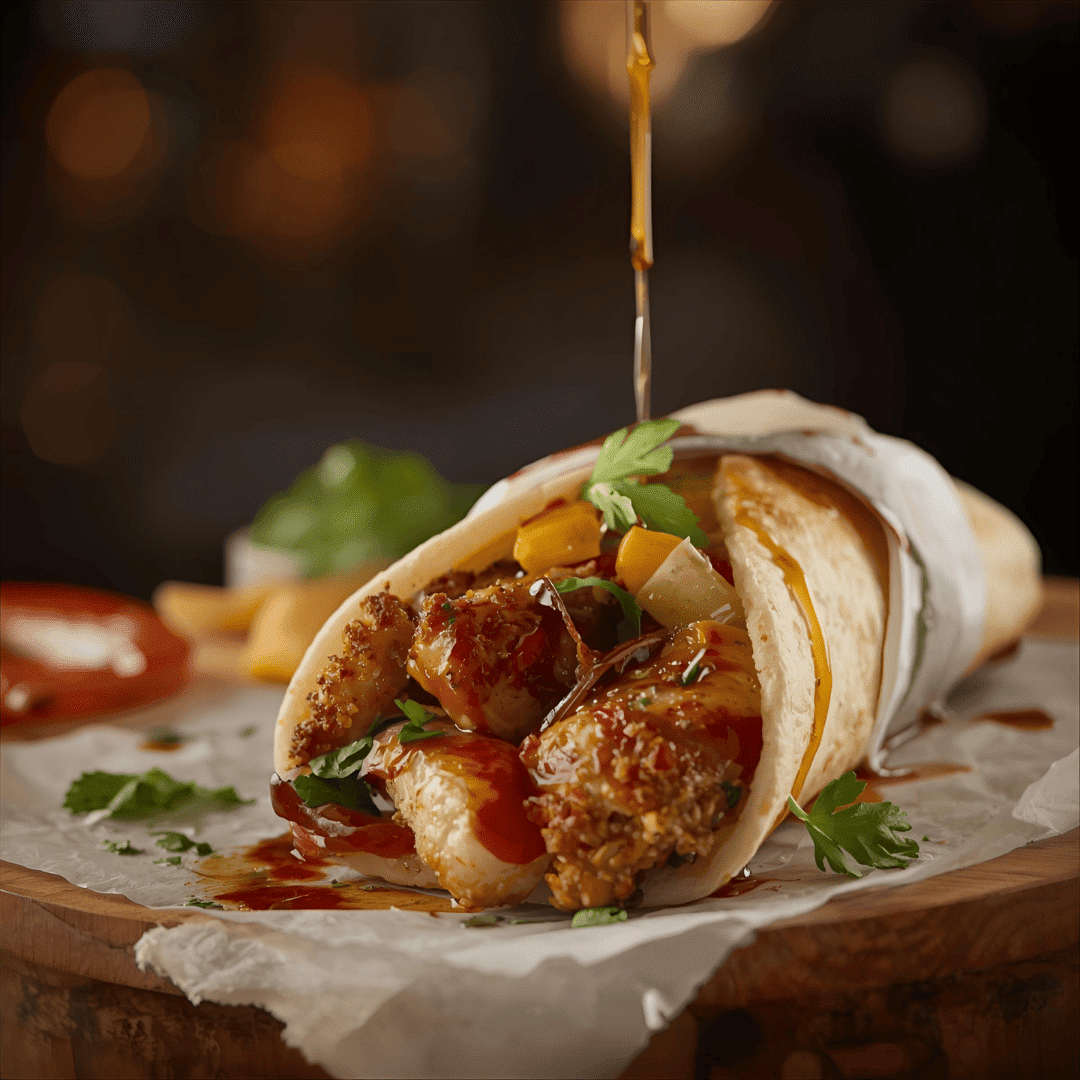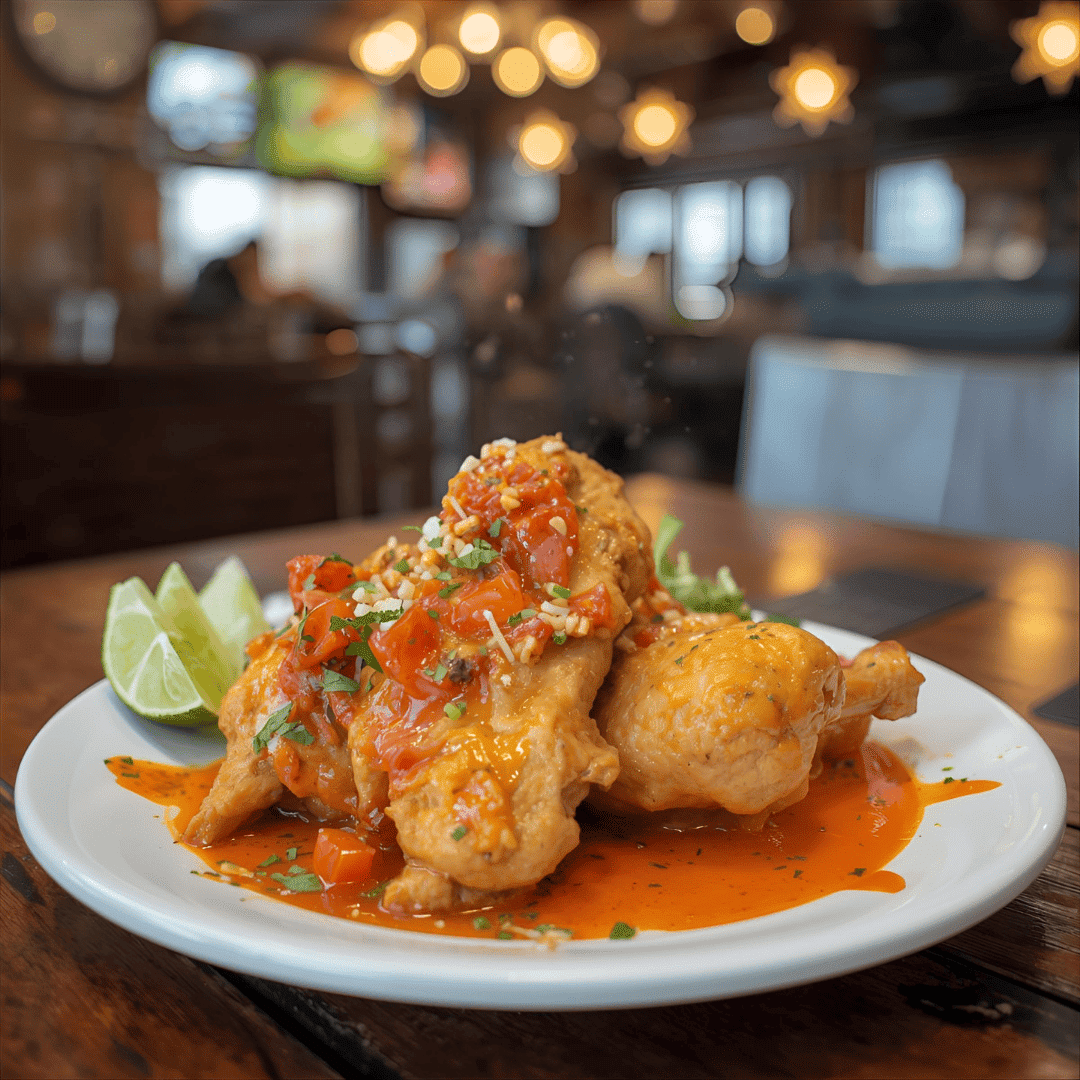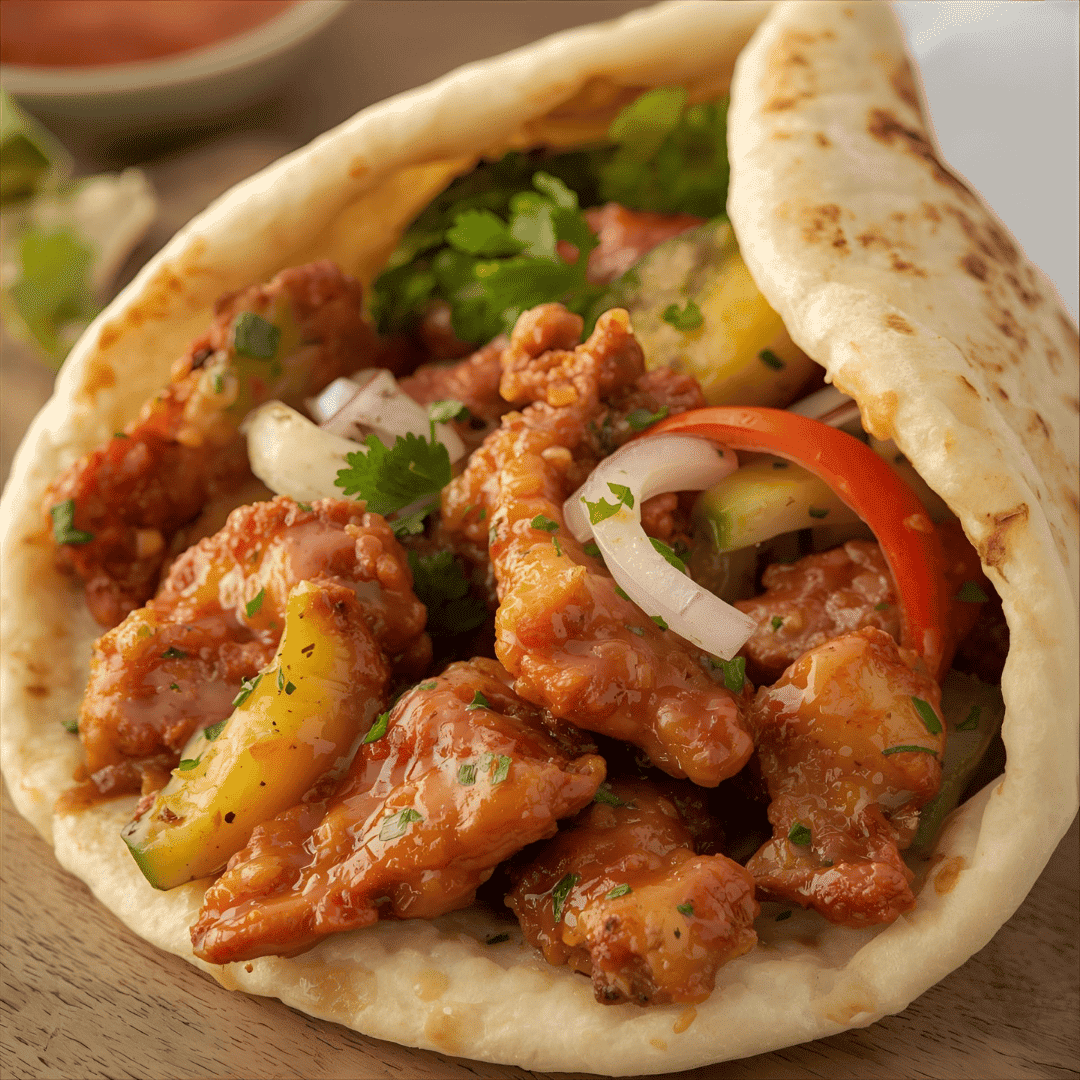Table of Contents
- Introduction: The Icon of the Street
- What Makes a Chicken Doner Wrap Truly Authentic?
- The Foundation: More Than Just Bread
- The Star: The Expertly Roasted Chicken Doner
- The Anatomy of a Flawless Chicken Doner Wrap Assembly
- The Flavor Base: The Critical Role of Sauces
- The Freshness Factor: Building the Salad
- The Main Event: Layering the Meat
- The Science and Art of the Fold: A Chef’s Practical Guide
- Why a Proper Fold is Essential for a Chicken Doner Wrap
- A Step-by-Step Wrapping Technique
- From My Experience: 3 Common Mistakes That Ruin a Chicken Doner Wrap
- Mistake #1: The Wrong Bread Choice
- Mistake #2: Overstuffing and Unbalanced Ratios
- Mistake #3: Stale, Pre-Carved Meat
- Is a Chicken Doner Wrap a Healthy Choice? A Trustworthy Breakdown
- A Nutritional Perspective on the Doner Wrap
- How to Make Your Chicken Doner Wrap Healthier
- Doner Wrap vs. Shawarma vs. Gyro: An Expert Clarification
- The Turkish Doner Wrap
- The Levantine Shawarma
- The Greek Gyro
- Frequently Asked Questions (FAQs) About the Chicken Doner Wrap
- Conclusion: Your New Standard for the Perfect Wrap
1. Introduction: The Icon of the Street
Around the world, there are few foods as instantly recognizable and universally loved as the doner. But for many, the pinnacle of this culinary invention is the chicken doner wrap. It’s the perfect, portable meal—a complete, satisfying dining experience you can hold in one hand. As a chef who has spent a career dedicated to the art of Turkish cuisine, I’ve personally built and wrapped thousands of doner wraps. From my experience, I can tell you that the difference between a mediocre wrap and a perfect one is a matter of expertise, respect for ingredients, and a deep understanding of the craft.
A great chicken doner wrap is a symphony of textures and temperatures: warm, succulent chicken, crisp, cool vegetables, tangy, creamy sauces, and a soft, fresh flatbread holding it all together. This guide is born from that firsthand experience. We will deconstruct every element, from the science of the marinade to the crucial art of the fold, to establish what truly makes a chicken doner wrap an unforgettable culinary icon.
2. What Makes a Chicken Doner Wrap Truly Authentic?
In Canada, the terms for “wrap” are often used interchangeably. However, in authentic Turkish cuisine, a wrap is a Dürüm, which specifically means “roll.” This distinction is key to understanding the foundation of an authentic chicken doner wrap. It’s not just meat in a piece of bread; it’s a specific, traditional preparation.
The Foundation: More Than Just Bread
The choice of bread is the first and most critical test of authenticity. From my experience, the most common mistake I see in non-specialist shops is the use of a thick, doughy pita. This is a fundamental error.
An authentic doner wrap is made with Lavaș (also spelled lavash) or a similar thin, pliable flatbread called yufka. The expertise behind this choice is twofold:
- Texture and Pliability: Lavaș is thin and flexible. It can be rolled tightly without breaking, creating a sealed, easy-to-eat package. A thick pita, by contrast, is meant for stuffing, not rolling. It cracks, leaks, and falls apart.
- Heat and Steam: The thin lavaș is traditionally warmed on the grill, often by pressing it against the rotating doner meat to soak up some of the juices. It becomes soft and warm but doesn’t become “bready” or overwhelming. It properly contains the ingredients, whereas a thick pita competes with them.
The bread is the vessel. A trustworthy establishment respects this and understands that the vessel is just as important as what it carries.
The Star: The Expertly Roasted Chicken Doner
The heart of the chicken doner wrap is, of course, the chicken. As we’ve explored in our other guides, this isn’t simply grilled chicken. It’s a product of immense skill.
- The Marinade (Expertise): The chicken (exclusively boneless, skinless thighs for their fat content) is marinated for up to 24 hours in a yogurt-based mixture. The lactic acid in the yogurt gently tenderizes the meat, a process that is far more subtle than the harsh chemical “cooking” from pure vinegar or citrus marinades.
- The Roast (Experience): The meat is layered and compacted onto a vertical spit. As it rotates, the outer layer cooks via intense radiant heat. This triggers the Maillard reaction, the chemical process responsible for the delicious, complex, and savory browned crust. Food science authorities like Serious Eats explain this as the reaction between amino acids and reducing sugars, creating hundreds of new flavor compounds. This crust is the “secret” to the doner’s addictive taste.
- The Carving (Trust): A true doner master carves the meat to order. Thin slices are shaved from the cooked outer layer, ensuring every wrap gets a perfect mix of caramelized, crispy bits and juicy, tender meat.
3. The Anatomy of a Flawless Chicken Doner Wrap Assembly
Building a chicken doner wrap is like architecture. The order of operations and the ratio of ingredients are paramount to its structural integrity and taste.
The Flavor Base: The Critical Role of Sauces
From my experience, the sauces should be the first layer. They act as a flavour-packed mortar that adheres to the bread and seasons the ingredients that follow.
- Garlic Yogurt Sauce (Sarımsaklı Yoğurt): A creamy, cooling, and tangy sauce. Its acidity cuts through the richness of the meat.
- Spicy Red Sauce (Acı Sos): A (usually) tomato and red pepper-based sauce that adds heat and depth.
Spreading a thin layer of one or both sauces on the lavaș first ensures that every bite is seasoned, and it also creates a slight moisture barrier to protect the bread.
The Freshness Factor: Building the Salad
The “salad” in a traditional chicken doner wrap is simple, and this simplicity is a sign of expertise. It’s not a heavy garden salad. It’s a curated selection of fresh, crisp vegetables designed to provide textural contrast. A typical, authentic mix includes:
- Shredded Lettuce
- Thinly Sliced Tomato
- Thinly Sliced Red Onion (often tossed with sumac, a tangy, lemony spice)
- Chopped Parsley
This combination provides crunch (lettuce), a burst of acidity (tomato, sumac onion), and a fresh, herbal note (parsley). It’s the perfect counterpoint to the warm, savory chicken.
The Main Event: Layering the Meat
The freshly carved chicken doner is layered over the salad and sauces. This is a practical tip for construction: placing the hot meat on top of the salad components slightly wilts them, releasing their aroma, but it protects the bread from becoming soggy too quickly. The meat is the heaviest component, so placing it in the center helps maintain the wrap’s balance. A final, light drizzle of sauce on top of the meat is a common finishing touch.
4. The Science and Art of the Fold: A Chef’s Practical Guide
This is where experience truly shows. A poorly folded chicken doner wrap will disintegrate within minutes, leading to a messy and frustrating experience for the customer. A well-folded dürüm can be eaten with one hand, with no leakage.
Why a Proper Fold is Essential for a Chicken Doner Wrap
The goal is to create a sealed pocket. The enemy of the wrap is leakage from the bottom. The traditional Turkish fold is designed specifically to prevent this. It creates a “bottom” for the wrap, turning the flatbread into a cone-like structure.
A Step-by-Step Wrapping Technique
Here is the method I teach in my kitchen, honed from wrapping thousands of doners:
- Position the Fillings: Place the fillings (sauce, salad, meat) in a line, slightly off-center and leaving about 2-3 inches of empty bread at the bottom and on the sides.
- The Bottom Fold: Take the 2-3 inch empty bottom flap and fold it up over the fillings. This is the most crucial step. This creates the “bottom” of the wrap and is what will prevent all the juices from running down your arm.
- The Side Tuck: Take the side of the bread closest to the fillings and fold it over the fillings and the bottom flap, tucking it in snugly. Use your fingers to keep the ingredients compact.
- The Roll: Continue to roll the wrap tightly in the same direction, keeping the bottom flap tucked in. The final product should be a tight, secure, and sealed dürüm.
This technique is a clear signal of expertise. It shows a level of care and experience that is essential for a trustworthy product.
5. From My Experience: 3 Common Mistakes That Ruin a Chicken Doner Wrap
As a professional, I can spot a bad chicken doner wrap from a mile away. Here are the three most common, trust-destroying mistakes to avoid.
Mistake #1: The Wrong Bread Choice
I’ve touched on this, but it bears repeating. Using a thick, pre-cut pita bread is a critical error. It is not designed for rolling. It will either be too “bready,” overwhelming the delicate flavor of the chicken, or it will be too stiff and will crack and break, spilling the contents. It’s an instant sign of a non-specialist.
Mistake #2: Overstuffing and Unbalanced Ratios
More is not always better. A common mistake is to overstuff a wrap to make it look bigger. This is a false economy. An overstuffed chicken doner wrap is impossible to fold correctly and will immediately fall apart. The sign of expertise is balance. The customer should taste the bread, the meat, the salad, and the sauce in every single bite. Too much bread and it’s dry; too much sauce and it’s a soggy mess; too much meat and it’s overwhelming.
Mistake #3: Stale, Pre-Carved Meat
This is the most unforgivable sin in the doner world. To save time, some places will carve a large pile of meat and keep it in a steam tray. This destroys the chicken doner. The meat becomes steamed, grey, and rubbery. It loses its signature crispy-caramelized edges and its juiciness. A trustworthy and authoritative kitchen always carves the meat fresh from the vertical spit, directly into the wrap. This is non-negotiable for quality.
6. Is a Chicken Doner Wrap a Healthy Choice? A Trustworthy Breakdown
In a world full of misinformation, providing honest, transparent nutritional context is a pillar of Trustworthiness (the “T” in E-A-A-T).
A Nutritional Perspective on the Doner Wrap
A chicken doner wrap is, at its core, fast food. However, when compared to many other fast-food options like burgers or fried chicken, it can be a surprisingly balanced choice.
- Protein: The chicken doner itself is a fantastic source of high-quality protein.
- Cooking Method: The meat is roasted, not deep-fried, which significantly reduces the unhealthy trans fats and excess calories from oil.
- Fresh Vegetables: The inclusion of a fresh salad provides fiber and essential vitamins.
- The Downsides: The potential downsides are sodium (from the marinade and sauces) and refined carbohydrates (from the flatbread).
Health Canada, in its official healthy eating guidelines, emphasizes a balance of protein foods, whole grains, and fruits/vegetables. A chicken doner wrap includes all of these categories, making it a more balanced option than many of its fast-food competitors.
How to Make Your Chicken Doner Wrap Healthier
As an expert, I can offer these practical tips for customers who are health-conscious:
- Ask for extra salad: This boosts the fiber and vitamin content and adds crunch.
- Go light on the sauce: The sauces, especially creamy ones, can add significant calories and fat. Ask for “light sauce” or get it on the side.
- Skip the extra salt: The meat is already seasoned.
7. Doner Wrap vs. Shawarma vs. Gyro: An Expert Clarification
This is one of the most common points of confusion for customers. Demonstrating expertise here is crucial for establishing authority. While all three are delicious, they are not the same.
The Turkish Doner Wrap
- Origin: Turkey (Ottoman Empire).
- Meat: Chicken, lamb, or beef.
- Marinade: Yogurt, paprika, oregano, cumin.
- Sauces: Garlic-yogurt sauce (not tzatziki) and a red spicy sauce.
- Fillings: Lettuce, tomato, onion with sumac, parsley. Pickles are sometimes served on the side, but less commonly inside.
The Levantine Shawarma
- Origin: The Levant (modern-day Lebanon, Syria, etc.).
- Meat: Chicken, beef, or lamb.
- Marinade: Different spice profile, often including turmeric, cardamom, allspice, and clove.
- Sauces: Primarily Toum (a potent garlic paste) for chicken, and Tahini (sesame paste sauce) for beef.
- Fillings: Heavily features pickles (especially pickled turnips), and sometimes french fries inside the wrap.
The Greek Gyro
- Origin: Greece.
- Meat: Typically pork or chicken, or a lamb/beef compressed cone.
- Marinade: Greek-style with oregano, thyme, and lemon.
- Sauces: Tzatziki (yogurt, cucumber, dill, and garlic sauce).
- Fillings: Served in a thick, fluffy pita bread (not a wrap), and almost always includes tomatoes, onions, and french fries inside.
As a culinary authority, TasteAtlas, a global food encyclopedia, confirms these distinct regional variations. Knowing the difference is a sign of true expertise.
8. Frequently Asked Questions (FAQs) About the Chicken Doner Wrap
1. What is in a typical chicken doner wrap? An authentic chicken doner wrap contains vertically roasted chicken, shredded lettuce, sliced tomatoes, onions (often with sumac), and parsley, all topped with a garlic-yogurt sauce and/or a spicy red sauce, and rolled in a thin lavaș flatbread.
2. What is the best bread for a doner wrap? From a professional standpoint, the best bread is a thin, pliable flatbread like lavaș or yufka. It’s strong enough to hold the ingredients without breaking and thin enough to not overwhelm the flavor of the chicken.
3. What sauce is on a chicken doner wrap? The two classic sauces are a white garlic-yogurt sauce (which is tangier and simpler than Greek tzatziki) and a red chili-based sauce.
4. How do you eat a chicken doner wrap without it falling apart? The key is in the fold. A well-wrapped dürüm should be folded at the bottom to create a sealed pocket. Hold the wrap from the bottom and eat from the top. As you get lower, you can gently peel back the paper it’s served in, which provides extra support.
5. Is chicken doner real chicken? Absolutely. At any trustworthy and authoritative establishment, the chicken doner is made from real, whole-muscle boneless chicken thighs, which are marinated, hand-stacked onto the spit, and roasted. Avoid places that use pre-formed, processed “loafs.”
9. Conclusion: Your New Standard for the Perfect Wrap
The chicken doner wrap is more than just street food; it’s a craft. It’s a perfect portable meal, but only when its construction is guided by experience and respect for tradition. From the lactic acid in the marinade to the crucial bottom-fold of the lavaș bread, every detail matters. A great wrap is a sign of a kitchen that has true expertise, and it delivers a product you can trust.
A final, practical tip from my years of experience: look at the spit. The spit should be hand-stacked, with visible layers of meat, not a perfectly smooth, uniform cone. It should be glistening and turning, with the chef carving it to order. This is your most reliable sign of quality.
We believe in this craft, and we invite you to taste the difference that expertise makes. Visit us at https://ottomanturkishgrill.ca/ to experience an authentic, perfectly constructed chicken doner wrap for yourself.





